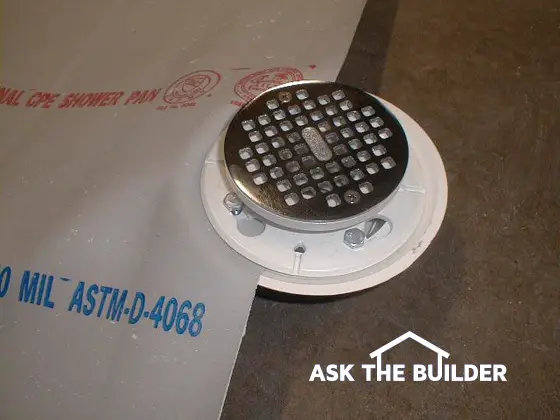Waterproof Ceramic Tile Floors

You must have the right drain assembly and the right membrane to have a lifetime of no leaks.
DEAR TIM: I built a shower stall on a concrete slab floor. Even though I caulked the seam between the walls and floor I get constant leakage on the other side of the shower. What did I do wrong? I need to figure this out before I install the wheelchair accessible shower upstairs. Robert D., Passiac, NJ
DEAR ROBERT: I'm not going to sugarcoat it. You really screwed up the basement shower. I'm afraid you are going to have to start over. The bad thing is that you probably will not be able to salvage much of the tile. Think of it as a tuition payment to the school of hard knocks!
Many people think that ceramic tile installations themselves are fairly watertight. They are far from that. Water can readily pass through tiny shrinkage cracks in the grout and around the contact point between the tile, grout and the shower drain. Leak proof tile showers incorporate special hidden membranes that are beneath the tile and a thin cement setting bed. You made your mistake thinking that the concrete slab would direct water to the drain. It simply doesn't work that way.
Years ago before the plastics industry was born, plumbers used thin sheets or lead for shower membranes or pans. They would skillfully form the lead into the bottom of the shower area and extend it up the shower walls approximately 9 to 12 inches. All seams would be soldered to make the pan leakproof. The lead connected to a special drain fitting that allowed water that seeped past the tile to go into the drain piping instead of your house.
I have written a cool eBook about Shower Pan Liners that shows you exactly how to install a shower pan liner. The book contains many step-by-step color photos and easy-to-follow instructions. Click here to see what other homeowners such as you have to say about it!
Lead shower pans over time do develop leaks. Corrosion happens for any number of reasons and tiny pinhole leaks cause water to spot ceilings and walls. When this happens or in the case of a new shower installation, it is time to call in the replacements. The premier shower pan membrane used today is a flexible plastic made from chlorinated polyethylene (CPE). I have used it countless times and have it in my own showers. I have never had a leak with this product.
You can buy other polyvinyl chloride (PVC) pan membranes but they tend to be stiffer and harder to work with. The PVC membranes have a memory and try to go back to their original shape when you try to bend them around wood corners. The CPE products are flexible and have no memory. They naturally conform to irregularities in wood framing and are very easy to work with. If it is necessary to seam pieces together, you use a special solvent that welds them together into one leak-proof piece.
Special clamping ring drains must be used with shower pan membranes. (See photo above.) These plumbing fittings have adjustable finished drains that allow you to adapt them to a wide variety of cement setting beds and tile thicknesses. The CPE or PVC membranes attach to the drain in the same manner that a rubber washer is sandwiched between a nut and a bolt. Once the clamping portion of the drain is tightened, all water that collects in the pan is directed to hidden weep holes within the drain fitting.
To prevent future leaks, you need to make sure the sub-floor beneath the liner slopes to the drain. If the liner is placed on a wood sub-floor, make sure all nail heads are recessed and there are no large splinters that could puncture the membrane. Small washed gravel needs to be placed over the weep holes as well. If you fail to do this, the cement base that supports the tile can clog these vital pathways that lead to the drain.
The floor and shower area for your wheelchair shower needs a special CPE liner that has fibers molded into it. These fibers allow thinset adhesive to be used directly over the membrane instead of a thick cement base. The thinset adhesive is like brick mortar and it readily adheres to the membrane's fibrous texture. If you follow the manufacturer's installation instructions, both of your showers will be leak free for years.
Related Articles: Shower Pan CPE Membranes, Shower Membrane Installation
Column 253